
The David Collection is a museum of fine and applied art in Copenhagen, Denmark, built around the private collections of lawyer, businessman and art collector C. L. David. The building at Kronprinsessegade 30 which houses the museum used to be the private home of the founder and was originally bought in 1810 by his great-grandfather, C. N. David, but sold again in 1830. In 1917 it was re-acquired by C. L. David, who took up residence in it but also made his collection available to the public at the upper floors of the building. Admission is free.

The Verrayon House is a Rococo, bourgeoisie townhouse located at Lille Strandstræde 6 in central Copenhagen, Denmark. It was listed by the Danish Heritage Agency in the Danish national registry of protected buildings in 1943.
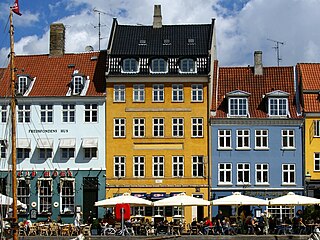
Nyhavn 23 is a Neoclassical property overlooking the Nyhavn Canal in central Copenhagen, Denmark. It was listed in the Danish registry of protected buildings and places in 1918. A plaque on the facade commemorates the composer Friedrich Kuhlau, who resided there in 1832.
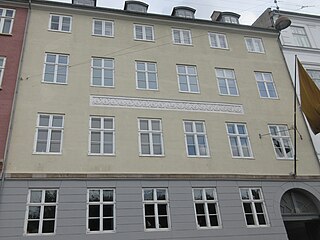
Kronprinsessegade 8, also known as Revisorenes Hus after its current owner, FSR - Danish Auditors´Danish Auditors Association, is a listed, Neoclassical property overlooking Rosenborg Castle Garden in central Copenhagen, Denmark. The building was listed on the Danish register of protected buildings and places in 1845.

Kronprinsessegade 20 is a Neoclassical property overlooking one of the entrances to Rosenborg Castle Garden in central Copenhagen, Denmark. It was listed on the Danish registry of protected buildings and places in 1945.

Kronprinsessegade 34 is a Neoclassical property overlooking Rosenborg Castle Garden in central Copenhagen, Denmark. It was listed on the Danish registry of protected buildings and places in 1945. Notable former residents include the writer Genrik Hertz and educator Athalia Schwartz.
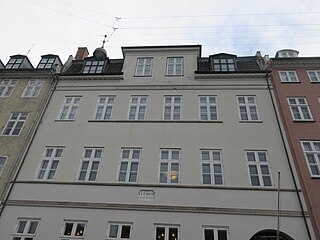
Kronprinsessegade 36 is a Neoclassical property overlooking Rosenborg Castle Garden in central Copenhagen, Denmark. A plaque embedded in the wall between the first and second floor commemorates that the composer Christoph Ernst Friedrich Weyse lived in the building from 1825 to 1842.

Kronprinsessegade 40 is a listed property located at the corner of Kronprinsessegade and Dronningens Tværgade in central Copenhagen, Denmark.
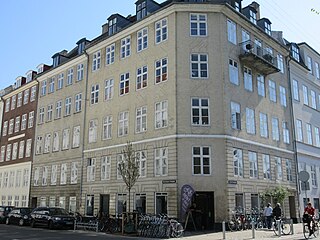
Kronprinsessegade 38 is a listed property located at the corner of Kronprinsessegade and Dronningens Tværgade in central Copenhagen, Denmark. It was listed on the Danish registry of protected buildings and places in 1945. Notable former residents include the politician C. G. Andræ, edicator Nathalie Zahle and painter Wilhelm Rosenstand.

Jacob Gade Kollegiet is a hall of residence for students at the Royal Danish Academy of Music located at Kronprinsessegade 44 in central Copenhagen, Denmark. The building is owned by Jacob Gades Legat, a foundation established by Jacob Gade. The building was listed on the Danish registry of protected buildings and places in 1945.

Kronprinsessegade 6 is a Neoclassical property overlooking Rosenborg Castle Garden in central Copenhagen, Denmark. It was listed on the Danish registry of protected buildings and places in 1945.

Kronprinsessegade 14 is a Neoclassical property overlooking Rosenborg Castle Garden in central Copenhagen, Denmark.
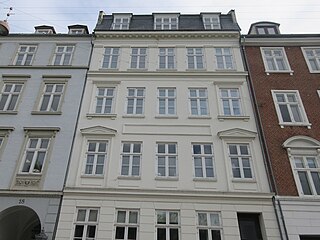
Kronprinsessegade 16 is a Neoclassical property overlooking Rosenborg Castle Garden in central Copenhagen, Denmark.

Kronprinsessegade 26 is a Neoclassical property overlooking Rosenborg Castle Garden in central Copenhagen, Denmark. The building was listed on the Danish registry of protected buildings and places in 1932.

Toldbodgade 5 is a 17th-century property situated in Toldbodgade, off Nyhavn in central Copenhagen, Denmark. It was listed in the Danish registry of protected buildings and places in 1977. The composer Carl Nielsen and the sculptor Anne Marie Carl-Nielsen resided in the apartment on the first floor from 1898 to 1906.

Kompagnistræde 32 is a Neoclassical property situated on Kompagnistræde, between Rådhusstræde and Hestemøllestræde, in the Old Town of Copenhagen, Denmark. Built with three storeys over a walk-out basement by Andreas Hallander in 1799, it was later expanded by one storey in the 1840s. A brewery was operated in a rear wing from its construction until at least the 1860s. The building was listed in the Danish registry of protected buildings and places in 1968. An adjacent warehouse and the rear wings are not part of the heritage listing. The Danish Union of Teachers was headquartered in the building from 1957. The union is now based at nearby Vandkunsten 12 but their old headquarters is still owned by them and let out as office space.
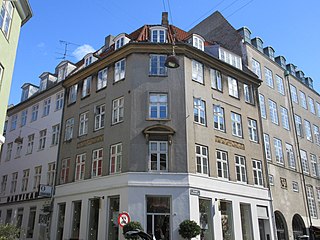
Læderstræde 36 is a Neoclassical building situated at the corner of Læderstræde and Hyskenstræde in the Old Town of Copenhagen, Denmark. The property was for around 100 years, from 1722 until some time after 1806 the site of a distillery. The adjacent building Hyskenstræde 9 was part of the same property until 1845. The two buildings were both constructed as part of the rebuilding of the city following the Copenhagen Fire of 1795, although the building in Hyskenstræde was subject to comprehensive alterations in 1834. The two buildings were individually listed in the Danish registry of protected buildings and places in 1964.

Kronprinsessegade 22–24 are two Neoclassical apartment buildings overlooking Rosenborg Castle Gardens in central Copenhagen, Denmark. They were both constructed by master mason A. C. Wilcken (ca.1760-1816) to designs by Andreas Hallander in 1807–1808. They were listed on the Danish registry of protected buildings and places in 1918 and 1945. Notable former residents include the theologian and politician Henrik Nicolai Clausen (1793-1877), judge Frederik Lütken (1808-1879) and physician Varl Lange. The latter operated a medical clinic at No. 22 from 1878 until his death in 1900.

Kronprinsessegade 32 is a Neoclassical apartment building overlooking Rosenborg Castle Garden in central Copenhagen, Denmark. The property was a few years after its completion in 1805 acquired by the ship captain Peter Nielsen Holbech. His granddaughter Ursula Dahlerup has provided a detailed account of the Holbech family's life in the building in her menoirs Fra Gammel Tid. Her father, portrait painter Niels Peter Holbech, who eventually inherited the property, could not handle his sudden prosperity and ended up squandering the family fortune. Other notable former residents include actor Christen Niemann Rosenkilde (1786-1861), author Peder Hjort, military officer Oluf Krabbe, Copenhagen Zoo-founder Niels Kjærbølling and actors N.P. Nielsen and Anna Mielsen (1803-1856) The building was listed in the Danish registry of protected buildings and places in 1918. In 1989, it was acquired by Davids Samling and used for an extension of the museum.

Kronprinsessegade 4 is a Baroque Revival style building overlooking Rosenborg Castle Garden in central Copenhagen, Denmark. Thje building owes its present Baroque Revival style facade to a carried out in 1912 by Gotfred Tvede for antiques dealer Carl Julius Petersen. Danske Kvinders Velfærd (DKV), a Christian-social organisation for women, was based in the building from 1925 to 1945.






















